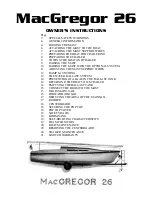
19
6.5 If the boat has Servo Assist winches fitted and is
to be steered manually, wind out (anticlockwise) the
helm winch drum to release the clutch. (fig 21)
6.6 If the boat is to be steered servo assist the clutch
needs to be engaged. Push the manual joystick hard
over to either port or starboard and do the same with
the helm winch by connecting battery and servo joy-
stick and push it over to either port or starboard as
done with the manual joystick. This should align the
clutch. Then wind in (clockwise) the star knob to en-
gage the clutch. (see fig 21)
6.7 To align the steering see Part 3, SERVO ASSIST
SYSTEM, 8.10 Adjusting the steering lines, page 25.
7.
LAUNCHING
7.1 Pass the bow line (called a painter) through the guide ring at the bow and fasten it
around the mast using a bowline (a knot which is always easy to untie).
7.2 Use a hoist to lower the keel in place. Keels are best carried on shore in a Keel
Caddy or a common hand truck.
7.3 DO NOT ALLOW ANYONE TO SAIL WITHOUT THE CENTREBOARD FULLY DOWN OR
THEY MAY CAPSIZE.
7.4 USE THE LONG ALLOY PIN TO LOCK THE CENTREBOARD DOWN
.
7.5 NEVER USE SEAT BELTS OR HARNESSES UNLESS THE CENTREBOARD IS LOCKED
DOWN.
Liberty Servo Assist System
1.
OVERVIEW
1.1 Access Dinghies are extremely easy to sail servo assist and a severely disabled
sailor can be very competitive against anyone. Unfortunately, however efficient servo
assist equipment may be, sheet and helm winches will always be mechanical and
without feel, and slower than an able bodied person working sheets and joystick
manually. But without doubt, its better to be sailing without feel than not sailing at
all.
1.2 Servo Assist equipment is fitted only to our single seaters for three reasons.
(a) Sailors who require servo assist generally have limited mobility which pro-
hibits them moving body weight to windward to counteract heeling. The
boat will therefore heel more and single seaters with their wide side decks
stay dry, even at extreme angles of heel.
(b) Sailors with limited mobility are more secure in the narrow single seater
cockpit.
(c) As winches are less responsive than manual control, the boat is likely to
occasionally be heeled more in wind gusts, so the single seater is dryer.
Fig. 21









































